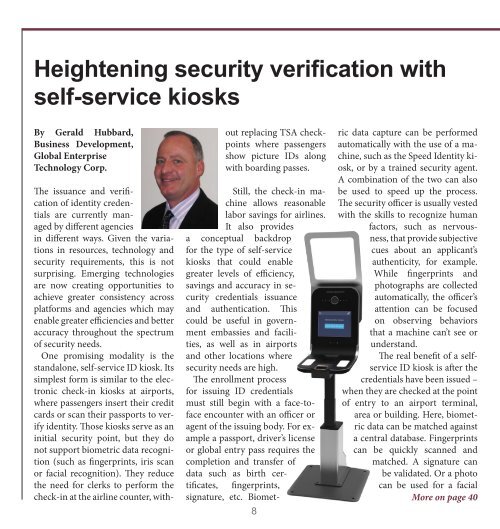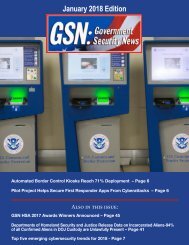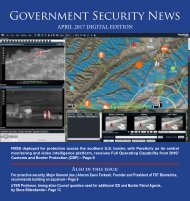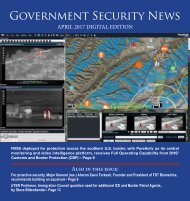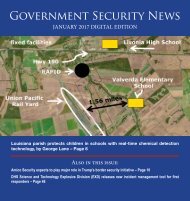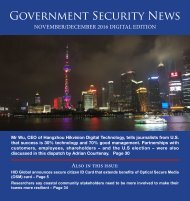GSN_Mar_YUMPU
Create successful ePaper yourself
Turn your PDF publications into a flip-book with our unique Google optimized e-Paper software.
Heightening security verification with<br />
self-service kiosks<br />
By Gerald Hubbard,<br />
Business Development,<br />
Global Enterprise<br />
Technology Corp.<br />
The issuance and verification<br />
of identity credentials<br />
are currently managed<br />
by different agencies<br />
in different ways. Given the variations<br />
in resources, technology and<br />
security requirements, this is not<br />
surprising. Emerging technologies<br />
are now creating opportunities to<br />
achieve greater consistency across<br />
platforms and agencies which may<br />
enable greater efficiencies and better<br />
accuracy throughout the spectrum<br />
of security needs.<br />
One promising modality is the<br />
standalone, self-service ID kiosk. Its<br />
simplest form is similar to the electronic<br />
check-in kiosks at airports,<br />
where passengers insert their credit<br />
cards or scan their passports to verify<br />
identity. Those kiosks serve as an<br />
initial security point, but they do<br />
not support biometric data recognition<br />
(such as fingerprints, iris scan<br />
or facial recognition). They reduce<br />
the need for clerks to perform the<br />
check-in at the airline counter, without<br />
replacing TSA checkpoints<br />
where passengers<br />
show picture IDs along<br />
with boarding passes.<br />
Still, the check-in machine<br />
allows reasonable<br />
labor savings for airlines.<br />
It also provides<br />
a conceptual backdrop<br />
for the type of self-service<br />
kiosks that could enable<br />
greater levels of efficiency,<br />
savings and accuracy in security<br />
credentials issuance<br />
and authentication. This<br />
could be useful in government<br />
embassies and facilities,<br />
as well as in airports<br />
and other locations where<br />
security needs are high.<br />
The enrollment process<br />
for issuing ID credentials<br />
must still begin with a face-toface<br />
encounter with an officer or<br />
agent of the issuing body. For example<br />
a passport, driver’s license<br />
or global entry pass requires the<br />
completion and transfer of<br />
data such as birth certificates,<br />
fingerprints,<br />
signature, etc. Biomet-<br />
8<br />
ric data capture can be performed<br />
automatically with the use of a machine,<br />
such as the Speed Identity kiosk,<br />
or by a trained security agent.<br />
A combination of the two can also<br />
be used to speed up the process.<br />
The security officer is usually vested<br />
with the skills to recognize human<br />
factors, such as nervousness,<br />
that provide subjective<br />
cues about an applicant’s<br />
authenticity, for example.<br />
While fingerprints and<br />
photographs are collected<br />
automatically, the officer’s<br />
attention can be focused<br />
on observing behaviors<br />
that a machine can’t see or<br />
understand.<br />
The real benefit of a selfservice<br />
ID kiosk is after the<br />
credentials have been issued –<br />
when they are checked at the point<br />
of entry to an airport terminal,<br />
area or building. Here, biometric<br />
data can be matched against<br />
a central database. Fingerprints<br />
can be quickly scanned and<br />
matched. A signature can<br />
be validated. Or a photo<br />
can be used for a facial<br />
More on page 40


